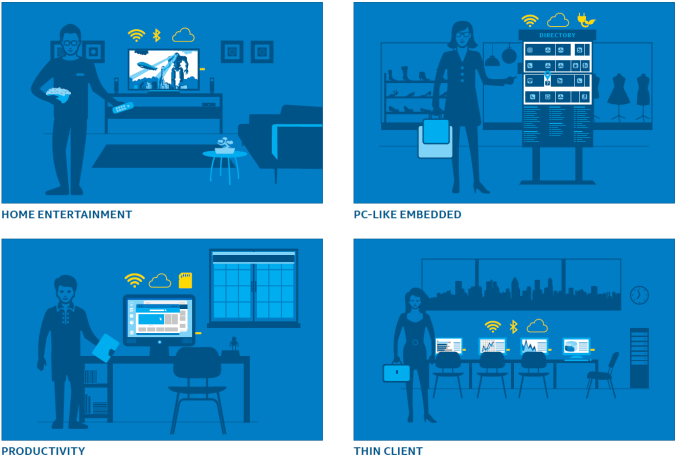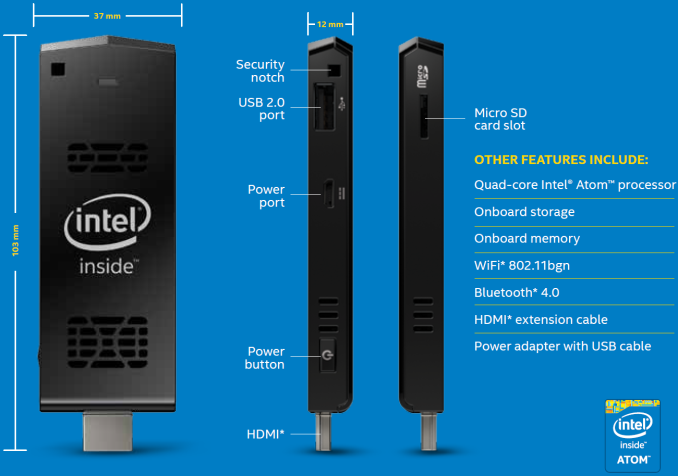Intel PPSTCK1A32WFC Bay Trail-T Compute Stick Review
by Ganesh T S on April 22, 2015 11:00 AM EST- Posted in
- Systems
- Intel
- Bay Trail
- HDMI Stick
Concluding Remarks
The Intel Compute Stick gave us the opportunity to see whether a tablet SoC could provide enough horsepower for a desktop PC. Based on our experience, the answer to that question is cautiously in the affirmative. There is no doubt that the device can do well as an economical solution for thin clients, kiosks and digital signage. These are scenarios where only one program runs for the life of the system and the OS is rarely updated.
The Compute Stick could do with some improvements for the scenarios in the left column
Traditional PCs have a different use-case compared to PC-like embedded systems and that brings us to the first problem in the Compute Stick we reviewed:
- OS drive size
32 GB, simply put, is just not enough after Windows installs a couple of updates. Out of the box, the system had around 17 GB free in the 23 GB disk (the rest, presumably, is the OS recovery partition). An initial update check resulted in a 1.3 GB download, and that installation brought down the free space to 14.3 GB. We have always been wary of Windows Updates on machines with low free space on the primary drive. As feared, attempting to install another round of updates resulted in a botched update problem (solved here). We had to spend 4+ hours getting the unit back to the initial state with a 'refresh' operation (and reinstall all the updates once again). To top it off, Windows lost activation in the refresh process and refused to reactivate (indicating a blacklisted key).
- Thermal design / solution
There is no doubt that the thermal design is very effective. Acoustic measurements come in at 28 dB at 1m distance. However, the irregular nature of the small-diameter fan makes for a strained experience if the user sits very close to the Compute Stick (possible in an office environment). It would not be a bad idea to go for a passively cooled Compute Stick at the cost of a slight increase in cost, weight and/or size.
- WLAN solution
The unit doesn't come with any wired networking facilities. It is essential that the Wi-Fi solution be top-notch. Unfortunately, a single-band 1x1 802.11n solution just doesn't cut it - particularly for scenarios involving video streaming. Thankfully, the presence of Bluetooth makes a USB keyboard / mouse unnecessary, freeing up the single USB 2.0 port for other purposes. Talking of video streaming, it would also be nice to have full HD audio support in the GPU drivers for Bay Trail-T (now that it has made its appearance in a mini-PC).
Despite the above shortcomings, the Compute Stick did impress us in a few areas - the form factor and portability aspects are praiseworthy. The CPU performance is not as bad as we feared it would be - Windows loads in a smooth manner and the system is as responsive as what one can expect from a Bay Trail-based mini-PC.
Coming to the business end of the review, we can say that the Intel Compute Stick is a typical first-generation product. In our opinion, there are way too many compromises being made to get to this form factor. There are certainly applications where the kit would be perfect, but general-purpose day-to-day computing is not one of them. If Intel wants the Compute Stick product line to take off like NUCs, addressing the three main shortcomings detailed above would be a good first step.












103 Comments
View All Comments
jabber - Thursday, April 23, 2015 - link
Yeah I was wondering this. Once you have Windows fully installed you can usually claw back 3-5GB easy. I've got fully setup Windows 10 preview installs down to around 11GB doing such things. DiskCleanup works wonders. 32GB is plenty for a light on the go setup. Why do folks still need to carry around TBs of data?zodiacfml - Friday, April 24, 2015 - link
Speaking of storage, Ganesh can you confirm if this runs using WIMBoot?I worked on WIMboot using a 32GB tablet with 19GB free space which includes educational software, latest updates, and Office 365 in the recovery image/partition.
ganeshts - Friday, April 24, 2015 - link
I suspect not, because I saw only 17.1 GB of 23 GB free after initial setup - no other programs installed.zodiacfml - Saturday, April 25, 2015 - link
Thanks. I wonder why they didn't bothered. I find that it works pretty well, might be even faster if the storage device has slow read speeds.I hope I could convince people in the office to purchase one of this. It looks fun especially after seeing the fan and heatsink in Tom's review.
Laststop311 - Thursday, April 23, 2015 - link
So basically the only use for this thing is turning a dumb tv into a smart tv? If you already have a DLNA compatible tv with a built in web browser what extra does this little stick bring to the table? I can already use DLNA streaming to stream movies, tv shows, and mp3's to my tv and I can use the built in web browser to browse the web and the built in youtube and netflix apps to use those services. I guess this thing is cool if your tv is a very basic model with no extra features or older before those features became almost standard.Other than streaming video and browsing the web there is nothing else this stick will be powerful enough to do and good smart tv's can already do all of this. You need an HTPC if you want to do other PC things on your tv as this stick doesn't have the power.
I have an ncase m1 htpc running an i7-3770t undervolted to 1.05v at stock clocks cooled with Noctua NH-C12P SE14 140mm fan with the ULNA adapter attached and coollaboratory liquid metal ultra TIM and the Noctua NF-B9-1600 92mm rear exhaust with ULNA adapter attached. Asus P8Z77-I deluxe mobo. 4x 120mm noctua intake fans all with ULNA attached (2x side 2x bottom). Silverstone 600 watt SFX PSU 80+ gold semi fanless mode. No optical drive have 512GB samsung 840 pro in slim optical drive bay. GSkill TridentX 2x8GB 2400Mhz Cas 10 DDR3. Recently added EVGA 4GB GTX 960 custom repasted with coollaboratory liquid metal ultra which replaced the GTX 660ti mainly for the hardware HEVC decode and the ability of the fans to shut off completely below 60C and a little for the gaming increase also for the decrease in power and heat. It has no standard HDD's and uses my NAS for bulk storage of movies and tv shows connected via 1Gbit ethernet as my house was completely wired for ethernet before wifi became a reliable thing. OS, apps and games installed on SSD.
Even though this system has infinite more power than the compute stick believe it or not it actually runs dead silent and may actually even be quieter. Even though this has 6 fans + 2 gpu fans and 1 psu fan the 6 noctua fans with ULNA adapters cannot be heard over ambient noise at all. The psu fan and gpu fans do not even turn on unless you are playing a demanding game and even then they can only be very slightly heard if there is a lull in the noise coming from inside the actual game. Haven't tested how demanding the hardware HEVC decode is on the gpu if it's enough to push the gpu over 60C to turn the fans on as I don't have a 4k tv yet but the way the ncase is set up the 2x 120mm intake fans on the bottom are just centimeters away from the GPU so the gpu gets cold air forced on to it at all times whether its fans are on or not which really helps from keeping the noisy gpu fans from ever coming on in all but the most demanding situations.
Yes I know the price difference is massive. As my system was 10 times the cost of the compute stick 1500 vs 150 and that doesn't even count the NAS system used to augment it. But I think it's money well spent as I can do more than 10 times the tasks the compute stick can at more than 10 times the speed.
I can only see the most casual of casual users ever wanting a stick like this. A real enthusiast will build a real HTPC and the 1500 is a large initial outlay but most of the parts can be reused for a long time coming. I won't need a new cpu and mobo till at least the 7nm tock and won't get a new ssd till the new cpu and mobo upgrade which will be an nvme ultra m2 with 1TB capacity and won't get a new GPU till at least 10nm as well unless major progress is made on video decoders. The case will be a forever thing as well as the PSU and fans at least until they die. Will have to get new ram only because of DDR4 taking over by the time the 7nm tock rolls around but prices will be like ddr3 prices now by then. The stick is so underpowered you will be buying new generations of it every single year out of desperation for more power and pretty soon the money difference isn't as large as it initially looks and you get so much more enjoyment out of a real HTPC.
Haravikk - Thursday, April 23, 2015 - link
I could understand the problems and compromises (like the fan) in a prototype, but this seems really poor for a final product. They could easily have avoided the fan by making the casing out of aluminium; sure it would be added cost, but not much, and would have resulted in a far superior product, as I don't know about anyone else, but I expect a stick computer to be silent like any good mobile phone.The Wi-Fi performance is also pretty shocking; this is a device that, by its nature, is likely to be stuck on the back of a monitor, so it's not an ideal location for good Wi-Fi reception to begin with, which means that good Wi-Fi performance is a prerequisite to any device of this type.
It's a shame, as it's not a bad processor with all things considered, and the other specs seem decent as well.
elbert - Thursday, April 23, 2015 - link
Were is the 1GB linux version for $89?stefstef - Thursday, April 23, 2015 - link
nice product. adds some value to a tv and fits perfectly in the gap between pc and mobile gadgets. would be already enough for me to do my work but, as with other products, the usability seems to be cut down due to the 2gb ram.Teetu - Thursday, April 23, 2015 - link
This is a good first effort. The second version, or competitors follow up, will be good enough to replace my ps3!mofongo7481 - Friday, April 24, 2015 - link
It might be fun to stream some Steam games from a gaming machine to it while hooked up to the TV.